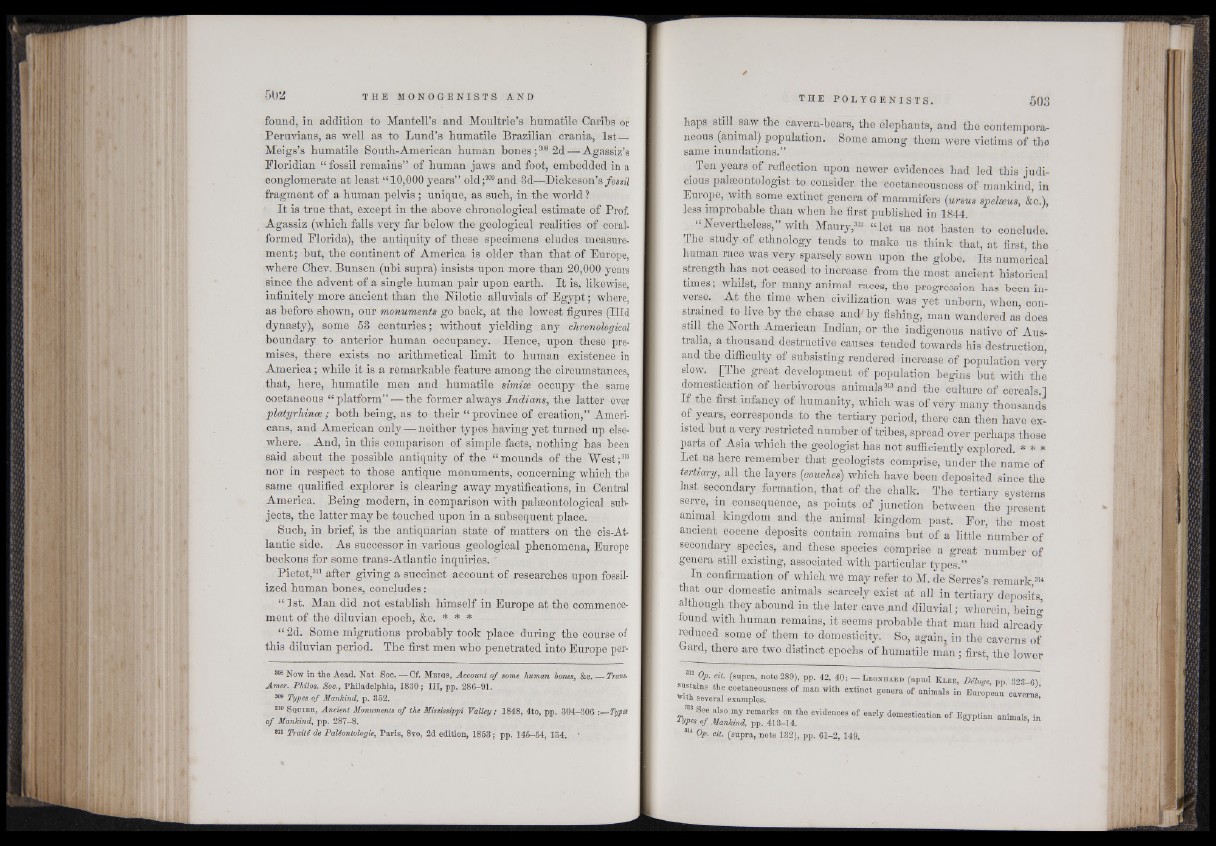
found, in addition to Mantell’s and Moultrie’s humatile Caribs or
Peruvians, as well as to Lund’s humatile Brazilian crania, 1st —
Meigs’s humatile South-American human bones;308 2d — Agassiz’s
Floridian “ fossil remains” of human jaws and foot, embedded in a
conglomerate at least “ 10,000 years” old;309 and 3d—Dickeson’s fossil
fragment of a human pelvis ; unique, as such, in the world ?
It is true that, except in the above chronological estimate of Prof.
Agassiz (which falls very far below the geological realities of coral-
formed Florida), the antiquity of these specimens eludes measurement;
but, the continent of America is older than that of Europe,
where Chev. Bunsen (ubi supra) insists upon more than 20,000 years
since the advent of a single human pair upon earth. It is, likewise,
infinitely more ancient than the Nilotic alluvials of Egypt ; where,
as before shown, our monuments go back, at the lowest figures (Hid
dynasty), some 53 centuries; without yielding any chronological
boundary to anterior human occupancy. Hence, upon these premises,
there exists no arithmetical limit to human existence in
America ; while it is a remarkable feature among the circumstances,
that, here, humatile men and humatile simiæ occupy the same
ooetaneous “ platform” — the former always Indians, the latter ever
platyrhince ; both being, as to their “ province of creation,” Americans,
and American only—-neither types having yet turned up elsewhere.
And, in this comparison of simple facts, nothing has been
said about the possible antiquity of the “mounds of the "West;314
nor in respect to those antique monuments, concerning which the
same qualified explorer is clearing away mystifications, in Central
America. Being modem, in comparison with palaeontological subjects,
the latter may be touched upon in a subséquent place.
Such, in brief, is the antiquarian state of matters on the cis-At-
lantic side. As successor in various geological phenomena, Europe
beckons for some trans-Atlantic inquiries. '
Pictet,311 after giving a succinct account of researches upon fossilized
human bones, concludes :
“ 1st. Man did not establish himself in Europe at the commencement
of the diluvian epoch, &c. * * *
P 2d. Some migrations probably took place during the course of
this diluvian period. The first men who penetrated into Europe per806
Now in the Acad. Nat. Soc. — Cf. Meigs, Account of some human hones, &c. Trans.
Amer. Philos. Soc., Philadelphia, 1830 ; III, pp. 286-91.
809 Types of Mankind, p. 352.
810 Squier, Ancient Monuments of the Mississippi Valley ; 1848, 4to, pp. 304-306 : Type*
of Mankind, pp. 287-8.
811 Traité de Paléontologie, Paris, 8yo, 2d edition, 1853 ; pp. 145-54, 154. *
haps still saw the cavern-bears, the elephants, and the contemporaneous
(animal) population. Some among them were victims of the
same inundations.”
s Ten years of reflection upon newer evidences had led this judicious
palaeontologist to consider the 'eoetaneousness of mankind, in
Europe, with some extinct genera of mammifers (ursus speleeus, &e.),
less improbable than when he first published in 1844.
“Nevertheless,” with Maury,313 “ let us not hasten to conclude.
The study of ethnology tends to make us think that, at first, the
human race was very sparsely sown upon the globe. Its numerical
strength has not ceased to increase from the most ancient historical
times; whilst, for many animal races, the progression has been inverse.
At the time when civilization was yet unborn, when, constrained
to live by the chase and/ by fishing, man wandered as does
still the North American Indian, or the indigenous native of Australia,
a thousand destructive causes tended towards his destruction,
and the difliculty of subsisting rendered increase of population very
slow. [The great development of population begins but with the
domestication of herbivorous animals313 and the culture of cereals.]
If the first infancy of humanity, which was of very'many thousands
of years, corresponds to the tertiary period, there can then have existed
but a very restricted number of tribes, spread oyer perhaps those
parts of Asia which the geologist has not sufficiently explored. * * *
Let us here remember that geologists comprise, under the name of
tertiary, all the layers (couches) which have been deposited since the
last secondary formation, that of the chalk. The tertiary systems
serve, m consequence, as points of junction between the present
animal kingdom and the animal kingdom past. For, the most
ancient eocene^ deposits contain remains but of a little number of
secondary species, and these species comprise a great number of
genera still existing, associated with particular types.”
In confirmation of which we may refer to M. de Serres’s remark314
that our domestic animals scarcely exist at all in tertiary deposits
a t ough they abound in the later cave.and diluvial; wherein, bein(T
found with human remains, it seems probable that man had already
reduced some of them to domesticity. So, again^ in the caverns of
rd, there are two distinct epochs of humatile man ; first, the lower
B l 11 (suPra> note289>’ PP- 42’ 40: — L e o n h a r d (apud K l e e , DUuge, pp. 328-61
sustains the eoetaneousness of man with extinct genera of animals in European caverns!
"iia several examples. *
•' *•”«• “■«« « -
814 Op. cit. (supra, note 132), pp. 61-2, 149.